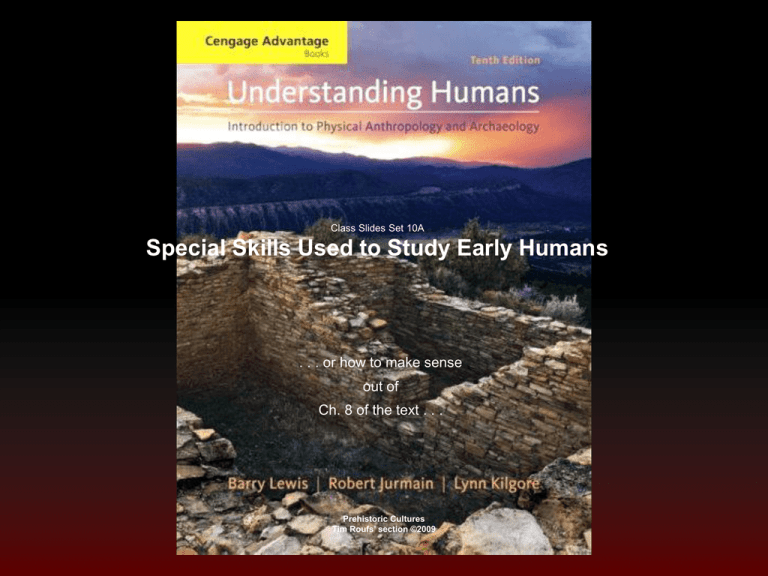PPT Archeological Dating Methods
advertisement

Class Slides Set 10A Special Skills Used to Study Early Humans . . . or how to make sense out of Ch. 8 of the text . . . Prehistoric Cultures Tim Roufs’ section ©2009 Archaeological Dating Methods In the Field and Lab methods = basic overall approaches to a problem techniques = specific tools / procedures used In the Field and Lab archaeological dating methods 1. relative dating 2. chronometric dating (aka “absolute” dating) Relative and Chronometric Dating Understanding Humans, 10th Ed., p. 189. REM: relative methods tell you whether something is older / younger / the same age Understanding Humans, 10th Ed., p. 188. methods REM: chronometric methods yield yield a date often scaled in calendar years Understanding Humans, 10th Ed., p. 188. method technique Relative and “Absolute” (Chronometric) Dating Techniques. Michels, Dating Methods in Archaeology, p. 4. techniques technique People of the Earth, 10th Ed., p. 11. In the Field and Lab stratigraphy the sequence of geological strata, or layers, formed by materials deposited by water or wind also the study of this sequence REM: relative methods tell you whether something is older / younger / the same age Understanding Humans, 10th Ed., p. 188. Humankind Emerging, 7th Ed., p. 24. People of the Earth, p. 18. Main gorge at Olduvai. Note geological beds. Understanding Humans, 10th Ed., p. 197. Bed I Olduvai Gorge, Kenya. Hoebel, Anthropology: The Study of Man and Archaeology, 4th Ed., p. 153. In the Field and Lab archaeological dating methods 1. relative dating 2. chronometric dating (aka “absolute” dating) In the Field and Lab archaeological dating methods 2. chronometric dating (aka “absolute” dating) provides estimates in actual numbers of years (sometimes +/-) Relative and Chronometric Dating Understanding Humans, 10th Ed., p. 189. In the Field and Lab archaeological dating methods 2. chronometric dating (aka “absolute” dating) determining the actual age of geological deposits (and the fossils in them) by examining the chemical composition of rock fragments and organic remains containing radioactive substances such as uranium 238, and carbon 14, which decay at a known rate In the Field and Lab A.1. or “First Order Absolute Dating” direct determination of age based on internal evidence e.g., 14C dating of bone sample e.g., dendrochronology e.g., molecular clocks Relative and Chronometric Dating Understanding Humans, 10th Ed., p. 189. Technician in a radiocarbon dating laboratory. Understanding Humans, 10th Ed., p. 194. Radiocarbon dating: • method was developed in the 1940’s by Willard Libby and a team of scientists at the University of Chicago. Very powerful in dating artifacts •and geological events up to about 50,000 years ago. Radiocarbon dating relies on a simple natural phenomenon. As the earth’s upper atmosphere is bombarded by cosmic radiation, atmospheric nitrogen is broken down into an unstable isotope of carbon– carbon 14 (C-14). Because it reacts identically to C-12 and C-13, C-14 becomes attached to complex organic molecules through photosynthesis in plants and becomes part of their molecular makeup. Animals eating those plants in turn absorb Carbon-14 as well as the stable isotopes. This process of ingesting C-14 continues as long as the plant or animal remains alive. The C-14 within an organism is continually decaying into stable carbon isotopes, but since the organism is absorbing more C-14 during its life, the ratio of C-12 remains about the same as the ratio in the atmosphere. When the organism dies, the ratio of C-14 within its carcass begins to gradually decrease. The ratio of decrease is ½ the quantity at death every 5,730 years. That is the half life of C-14. techniques technique People of the Earth, 10th Ed., p. 11.



